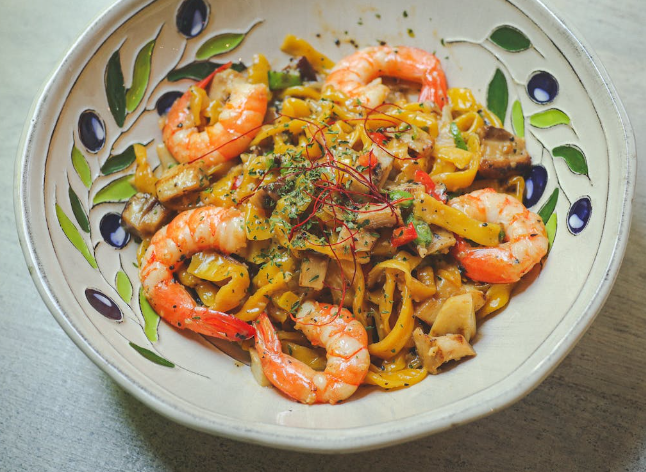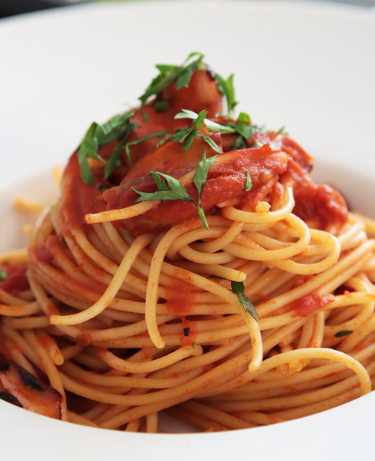You’ll barely break a sweat incorporating the health benefits of wild-caught seafood into your diet. With global seafood consumption increasing from 19.9kg to 20.5kg, it’s clear that people are embracing its nutritional advantages.
Marina Del Rey Wild, our #1 selling Wild Argentinian Shrimp, for example, offers unique flavors, enhanced texture, and culinary versatility, inspiring creative cooking and enjoyable dining experiences.
Canada’s Food Guide recommends regular consumption of foods rich in healthy fatty acids, such as fatty fish. They’re a rich source of essential nutrients (such as lean protein) that contribute to overall well-being and disease prevention.
In this guide, we’ll cover in detail why seafood from oceans, seas, rivers, or lakes (and not farm-raised) is not only delicious but also an essential component of a balanced diet.
Wild-caught Seafood vs. Farm Raised: The Benefits
If you’re wondering how these types of seafood compare, this table gives you an idea based on their benefits.
| Benefits | Wild-Caught Seafood | Farmed Seafood |
| Sustainability | Harvested from natural populations, maintaining ecosystem balance. | Provides consistent supply to meet demand without overfishing wild populations. |
| Flavor | Often considered to have a rich flavor and firmer texture | A milder flavor and softer texture |
| Variety | Diverse species captured in their natural habitats. | Cultivation allows for a wider range of species year-round. |
| Nutrition | Rich in omega-3 fatty acids and other essential nutrients. | Can be optimized for specific nutritional profiles through feed and environment management. |
| Economic Impact | Supports traditional fishing communities and local economies. | Provides employment opportunities and economic stability in rural areas. |
Key takeaways:
- Wild-caught seafoods are rich in flavors, inspired by nature.
- It encourages sustainable fishing practices.
- Enhance heart health with omega-3s.
- With wild-caught seafood, you savor lean, protein-packed meals.
- Seafood from the wild lets you embrace a nutrient-rich dining experience.
6 Health Benefits of Eating Wild-caught Seafood
Let’s explore the six associated health benefits of eating seafood, such as shrimps and lobsters directly from the wild:
1. Rich Source of Essential Nutrients
Indulging in wild-caught seafood isn’t just about enjoying delicious flavors; it’s also a fantastic way to nourish your body with essential nutrients.
Take omega-3 fatty acids, for instance – these powerhouse nutrients are vital for:
- Heart health.
- Brain function.
- Overall well-being.
Wild-caught salmon, known for its rich omega-3 content, offers a delectable example of this nutritional delicacy. Just a 3-ounce serving of wild-caught salmon can provide over 1,500 milligrams of omega-3s, surpassing the recommended daily intake for most adults.

These fatty acids play a crucial role in reducing inflammation, lowering blood pressure, and promoting cognitive function.
By incorporating this seafood like salmon into your diet regularly, you’re treating your taste buds to a culinary delight and also giving your body a generous dose of essential nutrients for optimal health.
2. Rich in Vitamin D to Boost Immune System
Wild-caught seafood is a valuable source of Vitamin D, crucial for bone health and immune function. For instance, a 3.5-ounce serving of wild-caught salmon provides about 386 IU of Vitamin D, nearly 64% of the daily recommended intake.
Additionally, seafood like shrimp and crab contains significant amounts of Zinc, vital for immune function and wound healing.
Just 3 ounces of crab meat delivers around 6.5 milligrams of Zinc, fulfilling nearly 59% of the daily recommended intake. Including wild-caught seafood in your diet ensures you receive these essential nutrients, supporting overall health and well-being.
3. Wild-caught Seafood is Source of Lean Protein
Seafood directly from the oceans and rivers serves as an excellent source of lean protein, making it a valuable addition to any diet. Unlike fattier cuts of meat, such as beef or pork, Shrimp and Lobster are both excellent lean protein sources that are easy to cook. A 3-ounce serving of Shrimp delivers up to 72 calories, which is equivalent to 17g of protein.
At Marina Del Rey, we’ve discovered an easy way to maximize the richness of lean protein in your meals, you may use these simple but healthy tips:
- Choose a variety: Incorporate a diverse range of wild-caught seafood like salmon, tuna, shrimp, and cod for balanced nutrition.
- Grilling and broiling: Opt for cooking methods like grilling or broiling to retain the natural flavors and nutrients of seafood.
- Minimal seasoning: Use light seasoning such as lemon, herbs, and spices to enhance flavor without adding unnecessary calories or sodium.
- Pair with whole grains: Serve seafood with whole grains like quinoa or brown rice to create a satisfying and nutritious meal.
- Include vegetables: Accompany seafood dishes with a variety of vegetables for added fiber, vitamins, and minerals, promoting overall health and satiety.
In addition, Lobsters are rich in high-quality protein, which is essential for muscle repair, growth, and overall cellular function.
As you incorporate this seafood variety into your meals, you’ll enjoy a satisfying and nutritious protein source without the added calories and unhealthy fats often found in other protein-rich foods.
4. Wild-caught Seafood is Low in Contaminants
This seafood has lower contaminants due to its natural habitat. Fish caught in the wild generally have less exposure to pollutants such as antibiotics, pesticides, and heavy metals commonly found in aquaculture settings.
This type of seafood often comes from pristine marine environments, where pollution levels are typically lower.
Consumers who want to reduce their exposure to harmful contaminants and enjoy seafood that’s naturally cleaner and safer to eat should opt for wild-caught seafood options.
This aspect underscores the importance of sourcing seafood from sustainable and well-regulated fisheries to ensure the health and safety of both consumers and the environment.
5. Environmental Sustainability
Consuming wild-caught shrimps, for instance, promotes environmental sustainability by supporting well-managed fisheries and preserving marine ecosystems.
If you’re concerned about retaining wildlife habitats and reducing pollution, then you’ll be glad to learn that wild-caught seafoods are harvested from natural environments with minimal human intervention.
Sustainable fishing practices, such as selective harvesting and ecosystem-based management, help maintain fish populations at healthy levels while minimizing bycatch and habitat damage.
This category of seafood from certified sustainable fisheries allows consumers to contribute to the conservation of marine biodiversity and ensure the long-term viability of fish stocks.
This supports sustainable fishing practices and incentivizes responsible stewardship of aquatic resources, fostering a more balanced and resilient marine ecosystem for future generations.
6 Versatility and Flavor
Seafoods from our rivers and oceans can be incorporated into salads, sandwiches, soups, and even sushi rolls, adding depth and complexity to any dish.
The distinct taste of wild-caught seafood is often attributed to its natural habitat and diet, which includes a diverse array of marine organisms and phytoplankton.
According to PubMed Central, 85% of consumers prefer its taste over farmed varieties. This results in a unique flavor profile that varies depending on the species and geographical location of the catch.
Whether savoring the delicate sweetness of Wild Caught Argentinian Shrimp or Wild Caught Canadian Snow Crab, these seafoods which are naturally rich in protein and low in calories will tantalize your taste buds and nourish your body.
The unparalleled flavor and adaptability of Marina Del Rey seafood make it a beloved ingredient in kitchens, cherished for its ability to elevate any meal from ordinary to extraordinary.
Economic Impact of Wild-caught Seafood
The economic impact of wild-caught seafood is profound, sustaining coastal communities, providing employment, and driving tourism. Industries reliant on fishing, processing, and distribution bolster local economies, while sustainable practices ensure long-term viability.
For example, in regions like New England and coastal Norway, fishing supports generations of families. Fresh seafood enhances tourism, attracting visitors seeking authentic culinary experiences.
By supporting sustainable fishing practices and local fisheries, consumers contribute to economic growth and cultural preservation, ensuring the prosperity of coastal communities worldwide.
Wild is Wonderful!
As many become aware of the health and environmental benefits of wild-caught seafood, it’s clear that this is the direction many are heading.
If you prefer a flavorful, sustainable option, Marina Del Rey Wild, the #1 Argentinian Shrimp brand in Canada, offers delicious seafood with a commitment to quality and responsible fishing practices.
Experience the difference and make a positive impact with Marina Del Rey Wild today!




